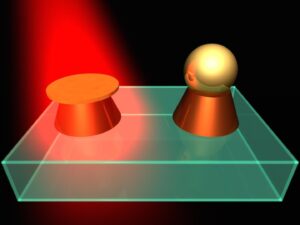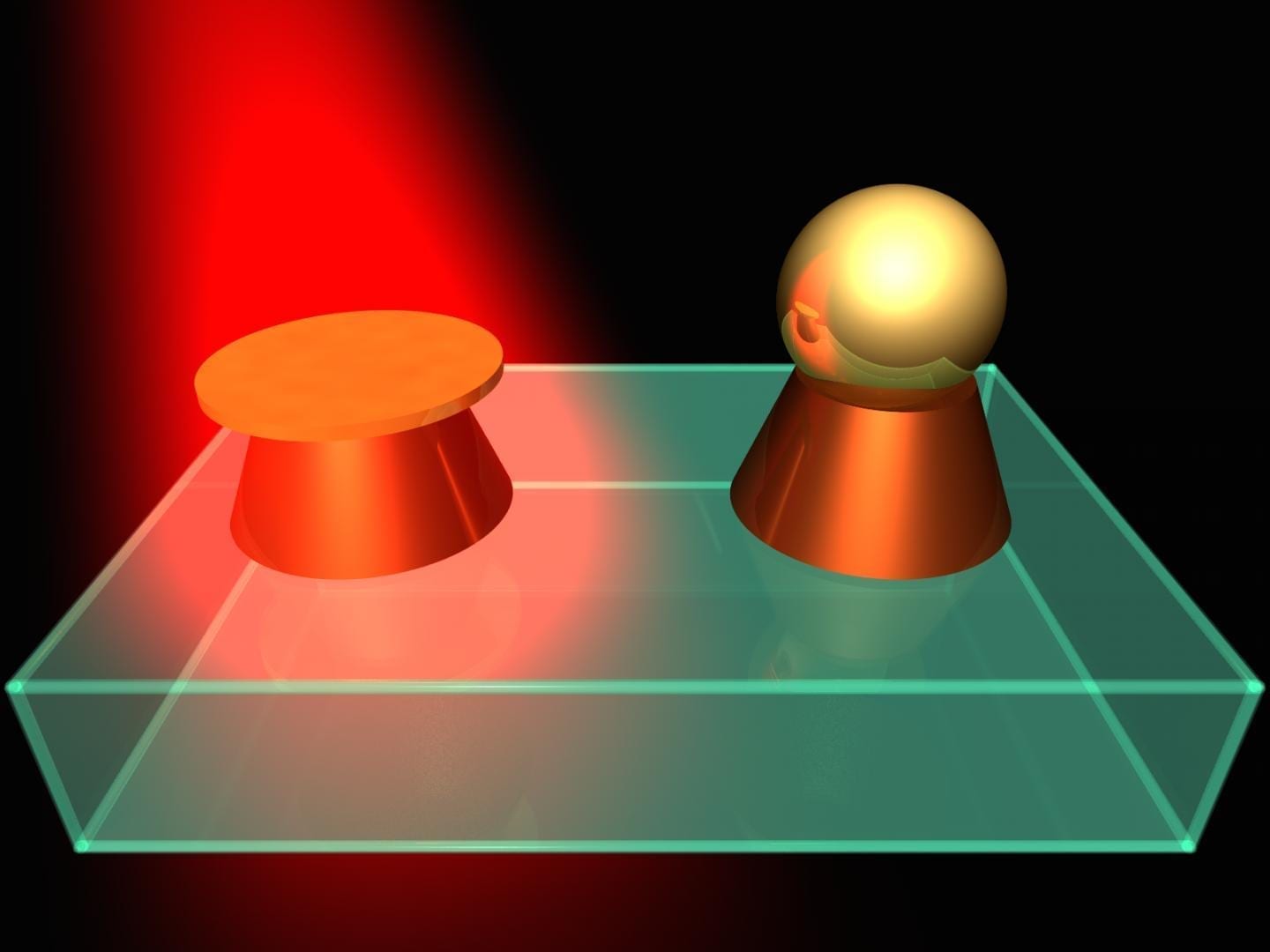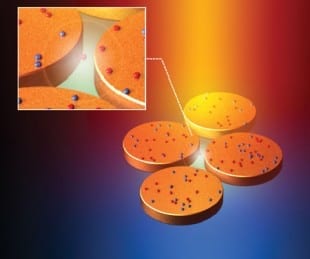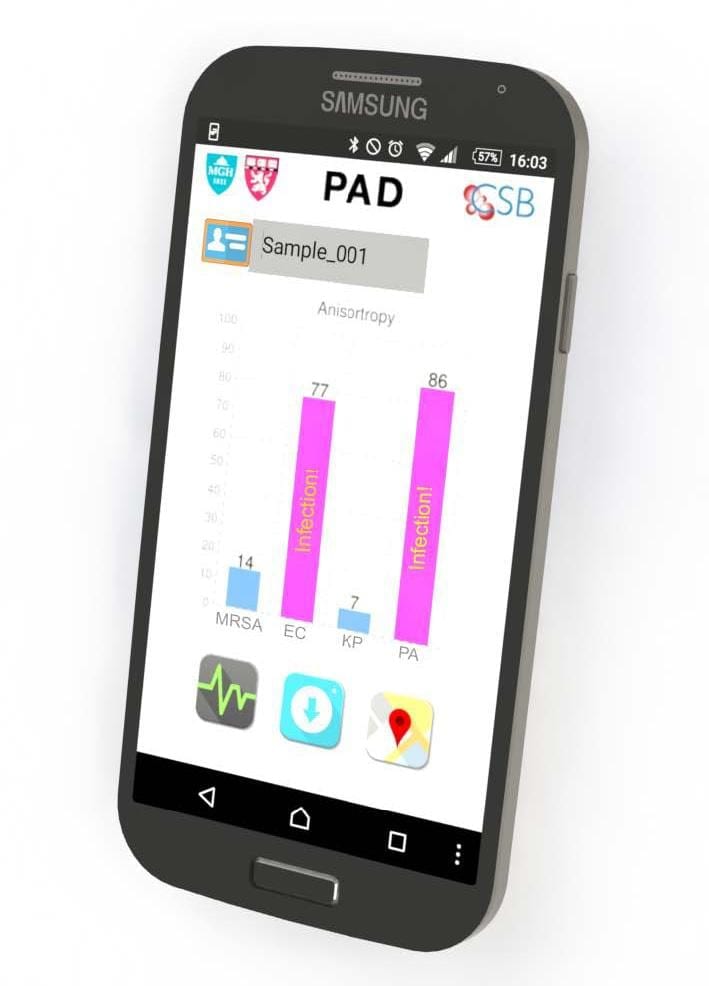
CREDIT: ITMO UNIVERSITY
A group of scientists from ITMO University in Saint Petersburg has put forward a new approach to effective manipulation of light at the nanoscale based on hybrid metal-dielectric nanoantennas. The new technology promises to bring about a new platform for ultradense optical data recording and pave the way to high throughput fabrication of a wide range of optical nanodevices capable of localizing, enhancing and manipulating light at the nanoscale.
The results of the study were published in Advanced Materials.
Nanoantenna is a device that converts freely propagating light into localized light – compressed into several tens of nanometers. The localization enables scientists to effectively control light at the nanoscale. This is one of the reasons why nanoantennas may become the fundamental building blocks of future optical computers that rely on photons instead of electrons to process and transmit information. This inevitable replacement of the information carrier is related to the fact that photons surpass electrons by several orders of magnitude in terms of information capacity, require less energy, rule out circuit heating and ensure high velocity data exchange.
Until recently, the production of planar arrays of hybrid nanoantennas for light manipulation was considered an extremely painstaking process. A solution to this problem was found by researchers from ITMO University in collaboration with colleagues from Saint Petersburg Academic University and Joint Institute for High Temperatures in Moscow. The research group has for the first time developed a technique for creating such arrays of hybrid nanoantennas and for high-accuracy adjustment of individual nanoantennas within the array. The achievement was made possible by subsequently combining two production stages: lithography and precise exposure of thenanoantenna to a femtosecond laser – ultrashort impulse laser.
The practical application of hybrid nanoantennas lies, in particular, within the field of ultradense data recording. Modern optical drives can record information with density around 10 Gbit/inch2, which equals to the size of a single pixel of a few hundred nanometers. Although such dimensions are comparable to the size of the nanoantennas, the scientists propose to additionally control their color in the visible spectrum. This procedure leads to the addition of yet another ‘dimension’ for data recording, which immediately increases the entire data storage capacity of the system.
Apart from ultradense data recording, the selective modification of hybrid nanoantennas can help create new designs of hybrid metasurfaces, waveguides and compact sensors for environmental monitoring. In the nearest future, the research group plans to focus on the development of such specific applications of their hybrid nanoantennas.
The nanoantennas are made of two components: a truncated silicon cone with a thin golden disk located on top. The researchers demonstrated that, thanks to nanoscale laser reshaping, it is possible to precisely modify the shape of the golden particle without affecting the silicon cone. The change in the shape of the golden particle results in changing optical properties of the nanoantenna as a whole due to different degrees of resonance overlap between the silicon and golden nanoparticles.
“Our method opens a possibility to gradually switch the optical properties of nanoantennas by means of selective laser melting of the golden particles. Depending on the intensity of the laser beam the golden particle will either remain disc-shaped, convert into a cup or become a globe. Such precise manipulation allows us to obtain a functional hybrid nanostructure with desired properties in the flicker of a second,” comments Sergey Makarov, one of the authors of the paper and researcher at the Department of Nanophotonics and Metamaterials of ITMO University.
Contrary to conventional heat-induced fabrication of nanoantennas, the new method raises the possibility of adjusting individual nanoantennas within the array and exerting precise control over overall optical properties of the hybrid nanostructures.
“Our concept of asymmetric hybrid nanoantennas unifies two approaches that were previously thought to be mutually exclusive: plasmonics and all-dielectric nanophotonics. Our hybrid nanostructures inherited the advantages of both approaches – localization and enhancement of light at the nanoscale, low optical losses and the ability to control the scattering power pattern. In turn, the use of laser reshaping helps us precisely and quickly change the optical properties of such structures and perhaps even record information with extremely high density,” concludes Dmitry Zuev, lead author of the study and researcher at the Department of Nanophotonics and Metamaterials of ITMO University.
Learn more: Hybrid nanoantennas — next-generation platform for ultradense data recording
The Latest on: Hybrid nanoantennas
[google_news title=”” keyword=”Hybrid nanoantennas” num_posts=”10″ blurb_length=”0″ show_thumb=”left”]
via Google News
The Latest on: Hybrid nanoantennas
- 8 Best Hybrid Mattresses for Side Sleepers 2024on April 29, 2024 at 5:00 pm
This will make sure your spine, shoulders, and hips stay in a neutral position. Hybrid mattresses — which are a combination of classic innerspring and foam mattresses — can be an amazing ...
- Hybrid carson April 29, 2024 at 5:00 pm
Alfa Romeo’s compact SUV with efficient plug-in hybrid power for under £300 a month: our Deal of the Day for 2 April is a no-brainer ...
- 6 Hybrid Vehicles To Stay Away From Buyingon April 28, 2024 at 4:00 am
Not all hybrid cars are created equal. While some models offer excellent fuel efficiency, reliability and performance, others fall short. With so many options, it can be tough to separate the good ...
- Hybrid ARM: What it Means and how it Workson April 24, 2024 at 5:00 pm
Oscar Wong/Getty Images A hybrid adjustable-rate mortgage, or hybrid ARM (also known as a "fixed-period ARM"), blends characteristics of a fixed-rate mortgage with an adjustable-rate mortgage.
- Best Hybrid Mattresses for 2024on April 23, 2024 at 1:00 am
McKenzie, a Certified Sleep Science Coach and proclaimed mattress expert, has been writing sleep content in the wellness space for over four years. After earning her certification from the Spencer ...
- EV vs. hybrid: Which one is best for you?on April 21, 2024 at 4:00 am
Whether or not an EV or hybrid is right for you depends on your circumstances and use-case scenarios. Here are some of the reasons why you might consider an EV or a hybrid and some of our top ...
- Every New Hybrid Truck You Can Buy in 2024on April 14, 2024 at 5:00 pm
Hybrid technology may have originally been developed to make econoboxes more economical, but these days adding some electric get-up-and-go to a vehicle can noticeably improve both fuel economy and ...
- What is a hybrid car and how does it work?on April 11, 2024 at 4:45 am
The arrival of the Honda Insight and the even more impactful Toyota Prius back in the 1990s ushered in the era of hybrid cars. Now, 25 years later, hybrid powertrains are enjoying a groundswell of ...
- The Toyota 4Runner is finally entering the future with a hybridon April 9, 2024 at 9:42 pm
But an all-new version is finally coming, and among the most notable changes is the addition of a hybrid option. The 4Runner shares a lot of its engineering, and a lot of history, with Toyota pickups.
- Why a Plug-In Hybrid May Be the Right Car for Youon April 4, 2024 at 3:40 am
If you are considering plugging into the electric vehicle revolution but worry about the potential hassles and uncertainties of charging on the road, a plug-in hybrid electric vehicle (PHEV ...
via Bing News











